Indoor Navigation: Great iBeacon Hardware Review
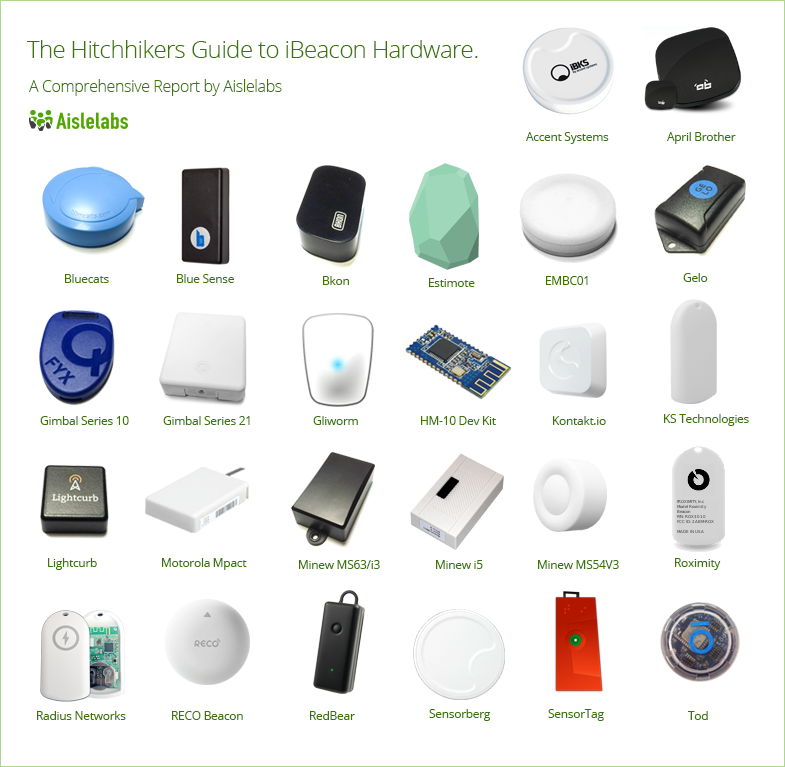
We have prepared a translation of a large review of beacons using the iBeacon technology, which is also used in the Navigine project - systems for indoor navigation. In Navigine, we use various technological solutions for indoor navigation, but iBeacon is one of the most famous and popular in the consumer sector - so we’ll start the story with it.
In this review, we will look at 26 iBeacon beacons from different manufacturers, such as Estimote, Kontakt and Gimbal. Over the past nine months, we tested the beacons in different conditions, trying to learn everything about them. This is the most comprehensive review on this topic, where all major manufacturers of beacons are rated.
Introduction
Apple's iBeacon technology helps smartphones determine their location in confined spaces. It is based on the BLE ( Bluetooth Low Energy ) protocol standard and is supported by all major mobile phones on Android and iOS platforms.
')
iBeacon is a tiny battery-powered device that transmits a Bluetooth signal. iBeacon (or simply beacons) repeatedly and every second transmit a signal, which, in turn, can be received by telephones within a radius of several meters. The phone can accurately determine its location based on signals from nearby beacons. Imagine that a telephone is a ship, and an iBeacon is a beacon mounted on a rock; ships, seeing the light of the lighthouse, can determine their location relative to the coast.
Beacons, in contrast to GPS, can be used for indoor navigation. The technology has found many applications - it is Indoor-navigation, geo-context advertising (services), customer marketing and personalized help. Since the beacons use the BLE standard, they work equally well with both Android and iOS devices.
As the protocol name suggests, [Low Energy] is a low-power standard. Earlier, we investigated the effect of beacons on the battery power of an iPhone and Android-based smartphones. As it turned out, working with nearby beacons should not spend more than 1% of the battery charge. In this review, we explore the battery life of the beacons themselves.
Beacons began to gain popularity not so long ago, but now they are already installed in countless stores. Most beacons are battery powered. In this review, we will conduct a full comparison of the various beacons available on the market. They come in different shapes and sizes, have different chipsets, firmware and battery sizes. Over the past nine months, we have tested 26 devices from different manufacturers. In the last review, we compared the effect of iBeacon on the battery charge of the phone, and in this we will compare the beacons themselves according to various parameters.
Energy consumption is a very important aspect, especially when installing beacons in a large industrial area. When there are a lot of them, it becomes very difficult to monitor the charge level of their batteries (and also to perform replacement). For this reason, it is desirable that the beacon has a capacious battery.
Winners:
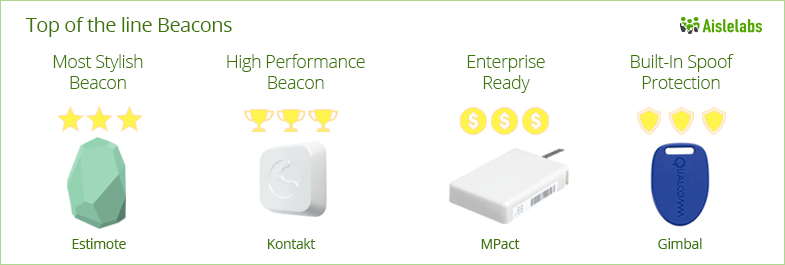
What are beacons
Beacons are small devices powered by batteries. They broadcast a bluetooth signal. The signal is received by smartphones and also transmitted to the cloud server via the Internet. Cloud servers process information and perform further analysis, controlling the behavior of the mobile application depending on the position of the smartphone.
The beacon consists of four main components:

Hardware beacons
The hardware consists of a microcontroller with a Bluetooth-radiochip and a battery. New radio chips are optimized to work with the BLE protocol, while the old ones support only classic Bluetooth, which has higher power consumption. Radio chips used in beacons are mainly produced by two companies: Texas Instruments and Nordic Semiconductor. BlueGiga and Gimbal companies use Texas Instruments (TI) radio chips, but with their own firmware.
Most of the beacons are equipped with flat round batteries of the “tablet” type. These are lithium-ion batteries, which, despite their size, provide up to 1000 mAh capacity. The most common batteries designed for 240 mAh (CR2032, small), 620 mAh (CR2450, medium size) and 1000 mAh (CR2477, large). These batteries are often used in key rings and digital watches.
Some beacons are equipped with alkaline AA batteries, which can often be found in digital cameras and television consoles. The capacity of a standard AA cell reaches 2000 mAh, but its size is larger than that of flat batteries.
Some of the beacons are connected to external power sources. They can be hooked up to either a power outlet or a USB connector. Such beacons do not require the replacement of batteries and, in certain situations, their use may be economically justified. However, it is not always easy to connect power to the place where the beacon is installed - additional wiring may be required. In this review, we will consider only beacons powered by batteries.

Flashing beacons
Each beacon has its own firmware - it is the program code (logic) that controls the operation of the hardware. The firmware can control several parameters that affect the battery life.
Transmission power (Tx) - beacons transmit a signal of a certain power. The transmitted signal weakens as you move away from the source. High transmit power means the signal can travel long distances. Low transmit power means low power consumption, but the signal will not spread far.
The polling interval is the frequency with which the iBeacon generates a signal. An interval of 100 ms in duration means that the signal will propagate every 100 milliseconds (10 times per second). A higher polling interval of 500 ms means that the signal will be transmitted only twice per second - the battery will be consumed less. As the polling interval increases, battery life increases, but the response time of the phone decreases. There is no optimal value for the polling interval: if low latency is required, the polling interval should be chosen as short as possible, and if the battery life is required to be extended, then as long as possible.
Apple’s official iBeacon protocol specification has a polling interval of 100 ms, however, most suppliers of beacons change its value in a larger direction, while adhering to other standards. We will still call such devices the term iBeacon. In most cases, a polling interval greater than 100 ms is more than enough to ensure a good user experience.
Each beacon has its own way of setting hardware parameters (transmit power and polling interval). Beacons such as Kontakt, Estimote, RadBeacon and BlueSense Networks use their own iPhone app to configure settings. Some beacons, such as Minew, provide an open interface through any GATT client (for example, an application for iPhone LightBlue or gattool on Linux). The main advantage of GATT clients is the ability to configure all beacons at the same time.
The beacons of some manufacturers (for example, Gimbal) additionally support their own modes of operation that are not described in the Apple iBeacon protocol. In this review we will cover only those modes of operation that are described in the standard.
We compared the various values of the transmit power and the polling interval and looked at what this leads to. Typically, the transmit power of beacons is -12 dBm , and the sampling frequency varies from 350 ms to 900 ms. The dependence of the range of the beacon on the transmission power (in visibility conditions) is shown in the diagram below:
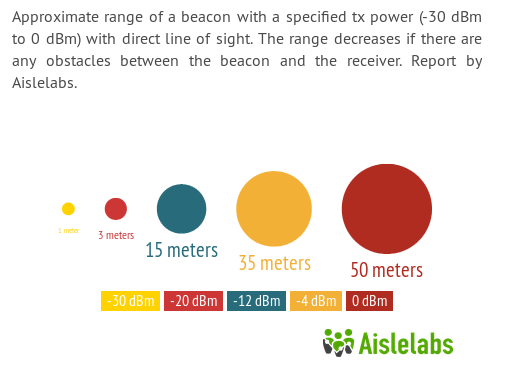
Cloud infrastructure beacons
The beacons transmit a Bluetooth signal that helps smartphones determine their location, but this signal does not mean anything by itself — an intelligent backend service is required here. Usually, cloud applications parse all received signals and make decisions, that is, they work as the brain that controls all operations.
In this review, we will not compare cloud service providers and focus only on beacon hardware.
Developer Package
Applications must be able to communicate with the beacons and the cloud server in order to act in accordance with the geographical location of the smartphone. In this review, we consider the battery beacons, the lifetime of which does not depend on the type of software package used for development.
Methodology
To accurately measure the lifetime of each battery, we placed beacons in our laboratory, setting various settings, and tested them over the past 3-9 months. All this time, we regularly measured the level of battery charge (initially charged at 100%). We also measured current consumption (in milliamperes).
We experimented with different transmit power settings and a polling interval. Each beacon has its own standard values for these parameters, so in order to create equal conditions, we set the transmit power to -12 dBm, and the polling interval of 645 ms is our optimal beacon setting.
Since the battery of many beacons lasted more than 9 months, we extrapolated the battery life based on the amount of current consumed. To do this, we divided the battery capacity (say, 620 mAh) by the current consumed to get an approximate battery discharge time.
This approach implies that the battery is ideal, and the current consumption is constant, but the lithium-ion battery does not meet these conditions. In reality, battery performance depends on many factors. Since different beacons come with different batteries (both good and bad), it is impossible to predict the exact operating time. Numbers reflecting the lifetime of batteries should be regarded as a theoretical maximum.
Standardization of battery life: We calculated the battery life of each beacon with the optimal settings, applying the methodology described above - this is how we standardized the battery life. This will allow us to directly compare the beacons with each other.
Below is a picture of our laboratory. Here are a few beacons and test smartphones.
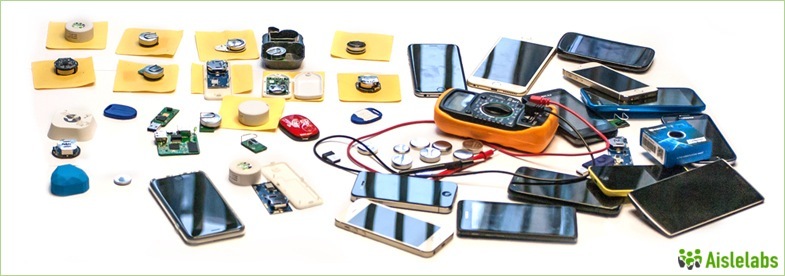
Chipsets
We focused on four chipsets - these are Texas Instruments TI CC254x , Nordic Semiconductor nRF51822 , Bluegiga BLE112 / BLE113 and a controller from Gimbal . Although there are other chipsets on the market, this represents 95% of the market (at the time of this writing [May 4, 2015 - approx. Lane]).
We carefully measured battery consumption with each of the chipsets. TI, Nordic and Bluegiga chipsets support various transmit power and polling interval settings. Gimbal additionally provides the ability to randomize the Bluetooth MAC (this function discharges the battery). Gimbal beacons support a limited set of configurations, and their polling interval cannot vary within arbitrary limits.
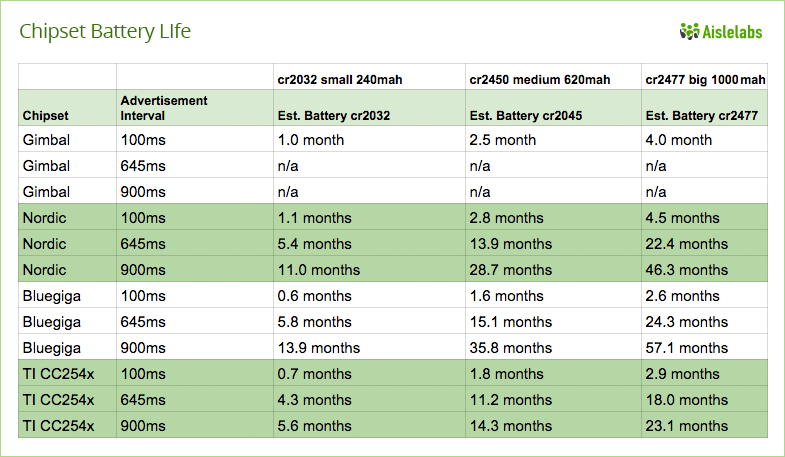
For each chipset, we calculated the battery life at optimal beacon settings: a polling interval of 645 ms, a transmission power of -12dBm (15 meters), a small CR2032 battery. Gimbal itself sets the polling interval to 100ms, so the values given for this chipset cannot be directly compared with the rest of the readings.
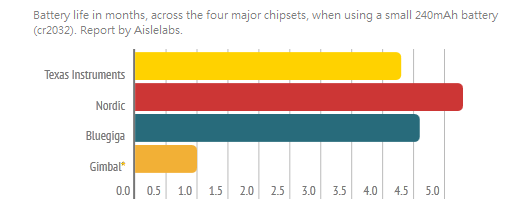
The most popular of the four chipsets are TI and Nordic. The TI chipset appeared in 2009, and Nordic in 2012. In this regard, it is expected that the Nordic chipset will be more optimized for working with beacons. The Gimbal chipset additionally provides its own Beacon mode, but here we consider only the iBeacon standard. We expect that these chipsets will be equipped with more modern radio transmitters in the near future.
Beacon Suppliers

Beacons IBKS 102 developed by the Spanish company Accent Systems. They come with a chipset from TI and are powered by a 1000 mAh battery (CR2477). Technical specification is available on the manufacturer's website .

AprilBeacon 241 is designed by April Brother, a Chinese company. They come with a TI chipset and are powered by a 620 mAh battery (CR2450). Larger beacons are also available, powered by an AAA battery, which ensure the uninterrupted operation of the beacon for 32 months. Technical specification is available on the manufacturer's website .

BKON, headquartered in Nashville, manufactures A1 beacons. They are equipped with two AAA batteries, ensuring long life of the device. There is support for the protocol UriBeacon - an alternative to iBeacon. Technical specification is available on the manufacturer's website .

In the beacons Bluecats AA used 2 AA batteries. Technical specification is available on the manufacturer's website .

BlueBar beacons are developed by BlueSense Networks, headquartered in the UK. They come with the Bluegiga BLE113 chipset and are powered by a 620 mAh battery (CR2450). Technical specification is available on the manufacturer's website .

EM Microelectronic is a Swiss semiconductor microelectronics manufacturer specializing in low-power chips for battery-powered devices. On its chips, the company produces beacons EMBC01. The company is owned by The Swatch Group, a Swiss watch manufacturer. Technical specification is available on the manufacturer's website .

Polish startup Estimote is one of the most famous manufacturers of beacons - the company releases them in a smooth silicone case. Releasing from Y-Combinator and receiving investor money from Silicon Valley, Estimote moved its headquarters to San Francisco. These beacons come with the Nordic Semiconductor NF51822 chipset. In a previous review, we tested the first batch of Estimote beacons, which were powered by batteries (CR2450) with a capacity of 620 mAh each. Starting in October 2014, the company releases updated beacons with 1000 mAh batteries. The beacon hardware is hidden in a non-separable case, so it can be installed outdoors and in places with high humidity, but this means that after discharging the battery cannot be replaced - you need to buy a new device.
Possessing an elastic silicone shell, a rich choice of colors and a reusable adhesive base, Estimote beacons are the most stylish devices in the market. Not so long ago, the company introduced Estimote Stickers thin beacons (only 3mm thick, but with a shorter battery life). Estimote also regularly releases firmware updates to further extend battery life.
The Estimote beacon setup is done using an iPhone app. Technical specification is available on the manufacturer's website .
The table below summarizes the lifetimes of the Estimote beacon batteries with firmware version 2.2 and a 1000 mAh battery. Note that the figures below imply the use of an ideal battery, which seems impossible in real conditions - the actual lifetime may be much less.

Comparison is by month (values in the table)

Water- and weather-resistant rough beacons from a company located in Michigan. Technical specifications for Gelo beacons are available on the manufacturer's website .

Qualcomm is an American semiconductor electronics company, best known for its Snapdragon processors, earlier this year opened the Gimbal manufacturing unit for beacons. With the support of Qualcomm, the new company has released beacons in several form factors: Gimbal Series 10 with a small battery and Gimbal Series 21 with four large AA batteries.

Comparison is by month (values in the table)

Gimbal beacons support two standards: Apple's iBeacon standard and its own. These are the only beacons that quickly change their Bluetooth address, providing protection from spoofing. Thanks to this protection, it is very difficult for an attacker to find out information about the beacon or to clone it. If such a function is not provided at the hardware level, then the protection of devices falls on the shoulders of the application developer. Since Gimbal has mechanisms to protect against spoofing, these beacons are an excellent solution in cases where software protection is not available.
Gimbal offers high-quality beacons that generate a stable signal, but have a bulky case and a short battery life. Several other manufacturers offer longer operation and a smaller form factor, giving users the ability to freely adjust the polling interval and other parameters.
Technical specifications for Gimbal beacons are available on the manufacturer's website .
The tables below show battery lifetimes (in months) for the Series 21 beacons while working on the Gimbal standard (recommended mode for Series 21) and iBeacon. Battery life is determined by the polling interval and transmit power.


Comparison is by month (values in the table)

Beacons Glimworm developed by the same German company. They come with a Texas Instruments chipset and a 620 mAh (CR2450) battery. Technical specifications for Glimworm beacons are available on the manufacturer's website .

The HM-10 is a UART bridge capable of working with the iBeacon protocol. This module is made for developers as an experienced kit. Technical specification .

Behind the development of these beacons is the Polish company Kontakt.io. Kontakt was born as a company offering devices that help people navigate the space blind and visually impaired. Today, their beacons help all segments of the population.
They come with a Nordic chipset and are powered by a 1000 mAh battery (CR2477). Having conducted several tests, we found out that the product architecture works fine with this chipset - a large signal transmission distance with relatively low power consumption.
Beacons can be configured using the Kontakt application or other applications (support for open standards). Easy configuration Kontakt simplifies the installation of a large number of beacons.
Technical specification .
The table below shows the dependence of the life time (in months) of the battery on two variables: the polling interval and the transmission power. The maximum lifetime was 35.7 months (900 ms polling interval, -20 dBm signal power). When setting the toughest settings, the battery life time decreased to 4.5 months.

Comparison is by month (values in the table)

These beacons are developed by the American company KST (KS Technologies). KST sells its equipment under the brand name Particle. They use a Nordic chipset and a 240 mAh battery (CR2032).
The simplicity of the design makes it easy to customize the beacons to the needs of the seller. KST operates under an OEM license, offering its services under the brands of other companies, and has registered its new device with FCC, IC and CE certificates.
Technical specification .

Lightcurb beacons are based on the Nordic chipset and provide a decent battery life.

Beacons Minew developed by the Chinese company Shenzhen Minew Technologies. There are several implementations of these beacons. We tested three options: MS54V3 with a CR 2477 battery, i5 with two CR 2477 batteries and MS63 / i3 with two AA batteries. Another option is the MS56, but we have not tested it, because it is identical to the MS54V3, only it has a silicone case for outdoor use. All beacons use the same chipset from Texas Instruments with the same firmware - only the batteries differ.

The table below shows the MS54V3 battery life with various settings. The battery life of i3 and i5 will be twice as long. The table shows the ideal battery life time (in months) depending on the transmission power (in dBm) and the polling interval (in ms).

Comparison is by month (values in the table)

Technical specifications for Minew beacons are available on the manufacturer's website .

The table shows the ideal battery life time (in months) depending on the transmission power (in dBm) and the polling interval (in ms). Note that at the time of testing, these beacons did not allow changing the polling interval of 100 ms and recommended by Apple. However, MPact beacons can now be used in iBeacon mode with a polling frequency of 600 ms, providing a battery life of up to 12 months.

MPact offers a platform for controlling beacons. The company produces Wi-Fi access points and combines all services related to navigation under the auspices of MPact. Since MPact is one of the few companies offering not only Bluetooth solutions, we have chosen this platform as ready to work in large enterprises. Other vendors, Meraki and Aruba, offering corporate solutions will be considered in the next version of this review. Technical specification .

Radius Networks is an American company that owns the RadBeacon Tag. These beacons come with a Nordic chipset and a 240 mAh battery (CR2032).
, CR2032, Radius Networks – USB RadBeacon USB. USB . , – , .

RECO ( ). Nordic (CR2450) 620 . .

RedBearLab. Texas Instruments 2000 . .

Roximity. Nordic (CR2032) 240 . .

Sensorberg. Texas Instruments (CR2450) 620 . .

Texas Instruments. (CR2032) 240 . .

tōd LLC. Bluegiga (CR2032) 240 . .
Conclusion
26 , 5 . , , :
- : Estimote;
- : Kontakt;
- : MPact;
- : Gimbal.
( ) . , , Gimbal MPact, , .
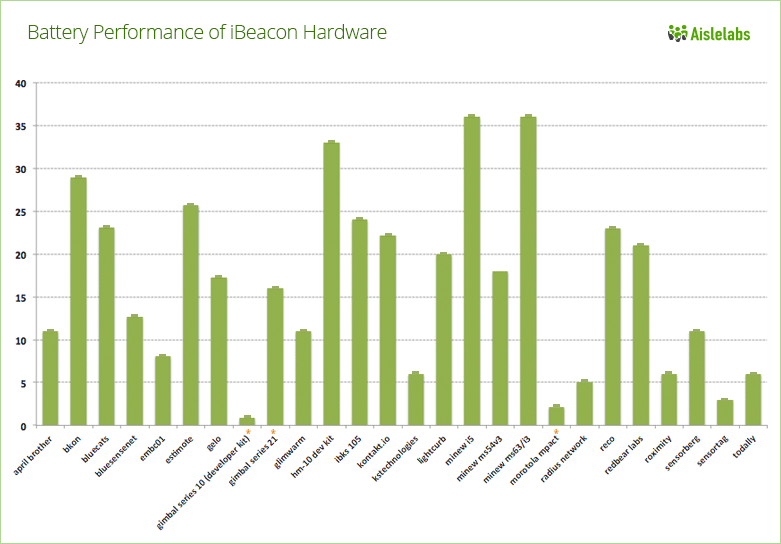
: Apple, iBeacon: , , Navigine ( GitHub), .
Source: https://habr.com/ru/post/269195/
All Articles